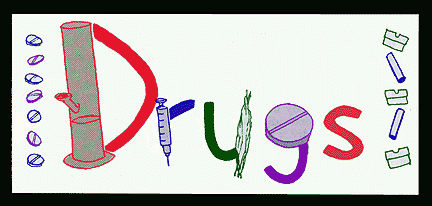
A
Corrosive Social Cement
"There are more junkies on Wall Street than most people realize,'' says Jack,
a trader at a brokerage house who is on methadone to deal with his heroin habit.
[New York Times May 20, 1984]
Businesses could not be profitable without constant and regular infusions of
drugs, both legal and illegal, into their workforces. Drugs are a vital ingredient
in the successful management of any workforce, even if management itself only
provides access to coffee, candy and cigarettes.
The provision of illegal drugs such as marijuana, cocaine and heroin is a multi-billion
dollar global industry which operates in a very flexible, efficient and decentralized
fashion, in spite of strong central control at the syndicate level. Taken as a
whole, the drug industry is a vital cement holding this society together.
The industries which produce drugs present many contradictions. The vast consumption
of legal caffeine, nicotine, and alcohol, and billions of doses of prescription
drugs such as valium, librium, etc., fuel major above-ground industries. Simultaneously,
the illegal drug trade in marijuana, cocaine, hallucinogens, and heroin provides
economic activity for several million people otherwise classified as "unemployed''
or "unemployable''—in addition to producing a nouveau riche of gangster millionaires.
Drug use is probably more widespread today than ever before. In analyzing recent
trends, a doctor who heads the largest private drug rehab program in the NYC
area, said that "20 years ago less than 4% of the population had used an illicit
drug. "Today, more than 35% of the population has used an illicit drug. It is
no longer a phenomenon of the minority poor, the underclass. Over 20 years,
there has been a de facto decriminalization of drug use. Our culture has said,
you want to get high, then get high.'' [New York Times May 23, 1984]
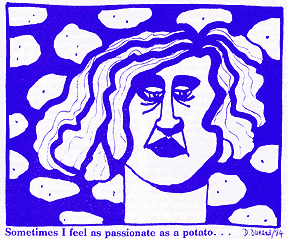
Why Take Drugs?
It is difficult to generalize about drugs. One person might take a sedative to
quiet inner anxiety, another takes "speed" to write an article or go dancing,
while still another takes some mushroms to explore a relationship with a close
friend. Meanwhile, a heavy cocaine user isn't having much fun with it anymore
and has become increasingly nervous and paranoid, so he starts snorting heroin
to calm down and mellow out. After a while the heroin becomes a habit, and the
cocaine is used (unsuccessfully) to avoid "coming down.''
The most positive reason to take drugs is to expand one's mental processes to
include other types of perceptions than merely those we are trained to see. At
least initially, marijuana, hallucinogens, and the harder drugs can provide stimulating
alterations of thought and perception. Especially in a materially and emotionally
impoverished world, finding a realm of wonder and amazement inside one's own head
is an exciting experience. It's also fun!
Taking pleasure in one's own thought processes, perceptions and feelings can be
a genuinely subversive experience. The use of drugs in the face of prohibition
is itself a mind-expanding experience vis a vis the state and the law. When you
can be busted for a harmless act such as smoking a joint, a new awareness of authority
and the law is gained. This in turn can produce a subversive consciousness if
acceptance of authority and law is rejected because experience has delegitimized
the system.
Drug use had this effect on me. Of course I used lots of prescription drugs for
colds, asthma, etc., as I was growing up. Then I was taught to fear and despise
illegal drugs in elementary and junior high school. Late to become interested
in experimenting with drugs, I finally started smoking pot when I was almost 17.
A high school English teacher encouraged me to read Herman Hesse's classic Steppenwolf,
and the Carlos Castaneda books. These stimulated my desire to try LSD, mushrooms,
and speed. I also read Aldous Huxley's The Doors of Perception which further
encouraged my intellectual curiosity about hallucinogens:
"In the [hallucinogenic] experience . . . place and distance cease to be of much
interest. The mind does its perceiving in terms of intensity of existence, profundity
of significance, relationships within a pattern . . . Not that the category of
space has been abolished. When I got up and walked about, I could do so quite
normally, without misjudging the whereabouts of objects. Space was still there,
but it had lost its predominance . . . And along with an indifference to space
there went an even more complete indifference to time: 'There seems to be plenty
of it,' was all I could [tell the investigator who asked me my feelings on 'time'].''—The
Doors of Perception
Cultures in all times have employed drugs to explore consciousness. Peyote and
psilocybin mushrooms have been commonly used in Native American religious rituals.
Even alcohol had a largely religious application several centuries ago. Only in
modern society have addiction and drug abuse become common phenomena. In each
case (coffee, tea, opium, tobacco, chocolate, mushrooms, pot, coca, etc.) a foreign
substance was removed from its native context and abused by modern society.
The problems we associate with drugs are not caused by the drugs themselves, but
by the attitudes and intentions people bring to their use. Nearly any kind of
drug can be useful and pleasurable if taken in full knowledge of the benefits
and the drawbacks, and if the drug is consciously used for specific purposes and
not as a mindless habit. For example, I've used hallucinogens to explore my brain,
'speed' to drive long distance and stay up late at night, pot to relax after work.
Most people agree that a little alcohol on a semi-regular basis is not a bad thing.
Many drugs can be used recreationally, e.g. I've danced on Percodan (synthetic
narcotic pain killer) and had quite a good time.
People have plenty of good non-hedonistic reasons to want to "get high,'' too.
The basic institutions and relationships of our society are based on authoritarian
and hierarchical organization and the buying and selling of human time. People
use drugs to numb themselves to the hypocrisy and stupidity of these basic facts.
It is the rare neighborhood or workplace where people are genuinely friends and
offer each other support and pleasure. Loneliness is tragically common in the
U.S. Drug use is a (frequently self-destructive) way to "get back'' at a world
in which life has been belittling and painful. Drugs can seem to eliminate, at
least temporarily, people's need for the social support and love which are not
there. It is easier to assuage loneliness, anxiety and pain through drugs than
it is to change the circumstances which produce those feelings.
In a world where "feeling good'' is for many a fleeting experience, drugs produce
a variety of pleasurable, if short-term, euphorias. Unfortunately, too many people
have so few "regular'' experiences that charge their mental sensibilities, that
drugs become their only way to get "high.'' They lose contact with their own desires
and no longer want to do much. Ultimately they replace the daily ups and downs
of their lives with the cycle of buying and consuming drugs, getting high and
coming down. Drug euphorias (from coke and heroin especially) come to replace
the pleasures derived from social experiences. In tying users more closely to
the drug network and the consumption cycle than to friends, family or neighbors,
drugs reinforce the social atomization that produced so much misery in the first
place.
The most important reason people use drugs is that they can see nothing better
to do. A 42-year-old heroin addict, recently paroled: "When I got out of prison
last October, three days after I got home I started using heroin again. I was
bored. There was nothing to do and I couldn't resist it . . . I've been on methadone
since December, and that takes care of my heroin problem. But I still need something,
so I'm using coke. I'm shooting it. Coke allows me to escape momentarily . . .
It's something to do, instead of sitting around, thinking of my miseries . . .
'' [NYT May 20, 1984]
In an atomized urban society, drug contacts provide a ready-made circle of "friends''
with whom to socialize. But their socialization tends to revolve around the buying,
selling and consuming of drugs. For those without close friends, or perhaps new
in town and without any contacts, drug circles provide the form, without the content,
of friendship. These superficial friendships are easily betrayed if a better deal
is to be made. Still, being with warm bodies in front of the TV, even if they're
conversational zombies, is preferable to a lonely night in a one- room with your
own small set.
Illegal drug use also continues to enjoy a certain mystique and status, in
which one is "cool'' for using drugs—the more conspicuously they are consumed,
the "cooler'' the user. This mystique crosses all kinds of social and racial
barriers. Just about any sub-group of the population has its own sub-group of
regular illegal drug users. And this generally includes all types of drugs,
for nearly any kind is readily available on the streets of North America.
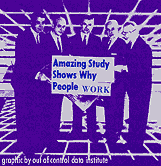
Drugs and Jobs
We know how crucial are our little breaks to surviving the eight- hour day are.
For most of us those little breaks are spent taking in some combination of legal
and illegal drugs: coffee and cigarette to try to wake up from the tedium of the
morning's tasks, or perhaps a joint followed by donut and coffee to put a little
spark in the feelings and perceptions, or maybe a nice cup of tea and a valium
to calm down after a bad morning at the copier, or a couple of lines of coke to
get through 4 hours of overtime . . . Some even sneak out to an isolated spot
where they can take a shot of heroin. And let's not forget the most ubiquitous
and debilitating drug of all, alcohol—acceptably ingested in massive quantities
near every worksite, especially downtown offices, at every lunch hour.
The extent to which drug use represents a "taking back'' of one's own time and
thoughts and erodes the work ethic is corroborated by some statistics about drug
use and job performance taken from a Newsweek cover story on August 22, 1983:
Joseph Lodge, a former Drug Enforcement Agency official, now running a drug counseling
firm in Miami, has come up with a computer profile of a "typical recreational
drug user in today's workforce'': He or she was born between 1948 and 1965, is
late three times more often than fellow employees, requests early dismissal or
time off during work 2.2 times more often, has 2.5 times as many absences of eight
days or more, uses three times the normal level of sick benefits, is five times
more likely to file a workmen's compensation claim. [emphasis added] They are
also more likely to have accidents, since attention is not always focused on the
boring work at hand. All of these methods of taking back time and money from employers
are indicators of the willingness to take back mental space from the work itself,
as well.
Not surprisingly, many companies think drugs are the cause of lost productivity
and lost profits, with estimates ranging from $16-26 billion annually. Drug abuse
counseling services within corporate Employee Assistance Programs (EAP's) are
becoming common. The point of these programs is only incidentally humanistic—the
primary reason is obviously to restore employees to a profitable status for the
company.
Employee Assistance Programs fail because they can't even acknowledge one of the
prime motivations for selling drugs in the first place: low wages. Messengers,
mail clerks, VDT operators, and all the low-wage grunts of the Information Army
can double and even triple their income, tax-free, by dealing pot and coke to
their co-workers. The same holds true for factory workers.
Nor can these programs cope with the causes of the stress which drive people to
drugs, namely intense work paces, boredom and bosses. The EAP's job is to fit
the "maladjusted'' workers to the company's norms, not to campaign for lighter
workloads or socially useful work. Even Newsweek, in its story on "Drugs in the
Workplace,'' concluded that the real roots of drug abuse lie in the fact that
"many jobs are. . . like torture. . . these people bring mind-altering drugs to
ease the boredom, the tension and the stress of doing their job.'' Once an "abuser''
agrees to seek help for a substance problem, the usual "treatment'' is a new,
legal drug, e.g. methadone, darvon, valium. Individuals are then coached in how
to go on living with just the right amount of drug use, and are offered prescriptions
for new drugs.
Mark, an investment counselor, and his wife, Louise, an executive for a public-relations
company, both heroin addicts, arrive together twice a week for their methadone
at the clinic on Wall Street. "I know I might have to use it for a long period,
or the rest of my life, but that's just like medication for a heart disease,''
Louise said. "That's how I look at it.''
"Methadone offers me stability,'' her husband said. "I have so many pressures
and worry that I can't kick it. I'm not afraid of the physical pain, but the emotional
pain of being without it.'' [NYT May 23, 1984]
Methadone is one of the biggest legal drug rackets in the country. Federally funded,
the program administers daily doses of methadone to tens of thousands of heroin
addicts in most major cities. Heroin was originally introduced as a cough suppressent,
then advertised as a "curative'' for morphine addiction around the turn of the
century. Now methadone, another sickeningly addictive narcotic, is offered as
the legal alternative to heroin. Instead of checking in with your dealer every
day, you check in with the government bureaucracy. Methadone allows some addicts
to stay drugged and still be socially functional, i.e. to keep working. But others
simply add the methadone dose to their repertoire of possible drug deals, as they
continue to use heroin and whatever else they're into.
Unfortunately, the existing methods of "rehabilitation'' are dubious at best.
They are characterized by two basic kinds of "treatment'': a new drug to replace
the illegal one, or going cold turkey in a halfway house. The regimen in the
halfway program usually involves breaking the addict's individual spirit and
reimposing respect for outside authority (we can imagine that there might be
another type of halfway program in which people genuinely helped each other
out and created a new community of affection and support, without the crutch
of authority). Following these prerequisites the reformed junkie is trained
to work (or look for work) instead of using drugs . . . unfortunately, most
jobs lead one right back to a desire for drugs, and a desire for the big money
to be made from selling drugs.
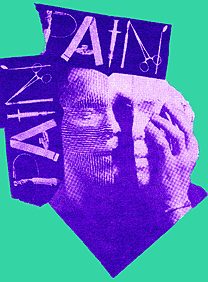
Hypocrisy and Repression
The differentiation between one drug's legality and another's illegality is arbitrary.
The same government which keeps marijuana illegal by classifying it as a dangerous
drug, continually allows violent carcinogens and mutagens to be used on our food
and in routine industrial processes. Even when chemicals are banned, they are
frequently exported to other countries and come right back to us in imported foodstuffs.
But the government doesn't keep drugs illegal for our own good. The real reasons
for maintaining illegal drugs seem to be to guarantee big profit margins to the
successful importers and dealers and to provide a pretext for social control.
Since certain drugs have a negative effect on "good working attitudes'' the suppression
is also partly motivated by a desire to control the workforce.
The gigantic criminal justice industry needs illegal drugs to exist. Otherwise
it would have to cut its budget, and many powerful people with vested interests
in the status quo would find themselves cut out of a lucrative arrangement. The
Drug Enforcement Agency [DEA] and all government anti-drug forces are dependent
on the drug agency to be the always-elusive foe—and of course the source of fat
kickbacks, friendly real estate deals, and the graft that is part of importing
drugs into the U.S. Most likely, the thousands employed in the spook bureaucracies
are involved not in stopping drug imports, but in seeing to it that the right
cocaine, heroin, and marijuana get in to the right people.
Recent newspaper reports indicate that record amounts of high- grade cocaine are
flooding the nation's streets, and that the wholesale price of cocaine has dropped
by 33% since the anti-drug programs were formed two years ago. Very efficient
importing to meet the enormous demand must be part of the reason for this drop
in price. In fact, the US has the biggest anti-drug bureaucracies in the world,
and yet continues to the biggest illegal-drug-using country in the world. It doesn't
take a great deal of imagination to see that there is a symbiotic relationship
between the importers and the law. Even if we could assume the DEA is an honest
organziation, it wouldn't be able to live up to its mandate. "To stop all the
drugs coming into New York, I'd need a Marine division,'' says Bruce Jensen, head
of DEA in NYC and suburbs.
As a pretext for hassling people, illegal drugs are popular excuses with authorities
everywhere. Whether crossing borders or just sitting in "People's Park'' in Berkeley
smoking a joint, ingesting or carrying any of a number of drugs invites conflict
with the law. Most urban dwellers have observed a cop who took a dislike to someone's
looks, race, clothes, whatever, searches them, and ends up busting him/her for
carrying weed or pills.
More recently, the pursuit of illegal drug use in the workplace has provided a
rationalization for totalitarian behavior on the part of employers: undercover
investigations of workers, blood, urine and lie detector tests, dog searches,
etc. The overall impact of this is to intimidate workers, and to deny even the
most basic rights of privacy, reinforcing management's hand against workers' self-organization.
Illegal drug use is an ambiguous social adhesive. It does contribute to an expanded
awareness for many, and can play an important role in stimulating the subversive
spirit. But this society needs ways for people to be apparently against it, even
when they are actually under control
Drug use is a regular indulgence in illegal behavior but is entirely consistent
with the rest of daily life: consuming various types of food, entertainment,
and travel commodities. The mystique of illegal drugs also reinforces the common
advertising myth that one can find happiness and satisfaction through the consumption
of merchandise. In spite of legal repression, the drug industry serves an important
validating role in today's society.
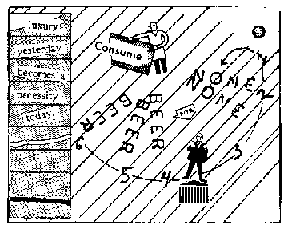
graphic by Bart Plantenga
The Drug Industries
Drug production is a dominant industry in many countries. A major part of the
economies of Colombia, Peru, and Bolivia is fueled by cocaine money. Pakistani,
Iranian, Afghani, Mexican, Burmese and Thai peasants cultivate vast acres of poppy
for processing into heroin. There are millions of acres of coca-, poppy-, and
marijuana-producing fields and thousands of drug processing factories throughout
the world, exporting vast quantities to lucrative urban markets.
Legal pharmaceuticals constitute a gigantic world-wide industry. In the U.S. alone,
tranquilizers comprise 25% of the total $8 billion annual drug market. Many prescription
drugs in the U.S. are sold over the counter in 3rd World countries (e.g. Darvon
in Mexico), and produce enormous profits for a few giant drug multinationals:
Ciba-Geigy, Hoffman-LaRoche, Eli Lilly, Sandoz, Smith Kline & French, etc.
If the National Organization for the Reform of Marijuana Laws (NORML) is right,
the value of the 1983-84 pot crop in the U.S. was $13.9 billion—a figure it characterized
as "conservative.'' That would put it ahead of corn as the number one U.S. cash
crop.
Thousands of people have found marijuana farming an escape from wage-labor, and
a way to be self-employed. In fact, marijuana farmng is so big in the U.S. that
strides in botanical and genetic research are being compared to the "pioneer corn
breeders [who] worked feverishly in the '30s to develop tougher, better-yielding
hybrids.'' [S.F. Chronicle, April 4, 1984]
Thomas Byrne, head of DEA's cannabis investigation section is quoted in the paper:
"we don't dispute that a large percentage of the population uses marijuana.—
and there is a tremendous amount grown for home consumption.'' The DEA estimates
that only about 10 to 15% of the annual national crop is seized. That leaves upward
of 35 million pot plants being harvested and smoked each year.
With so much marijuana being grown and sold, it can only get into the hands of
millions of consumers through an effective and flexible distribution network.
Being a local marijuana merchant has become a common way for people to "start
their own busienss'' with very little capital up front. Middlemen in dope deals
can net upwards of $20,000-40,000 per year, as long as they don't squander their
money on drugs! And best of all it's tax free — the only tax is the Anxiety
Tax, which comes from the possibility of being ripped off or busted.
Significantly, neither the marijuana farmer, nor the marijuana dealer is engaged
in dangerous behavior (for capitalism). Each is successfully avoiding wage-labor
by having a small business. They are following the time-honored American tradition
of free enterprise, in some cases even reviving an agrarian lifestyle. The illegality
of the industry means they can enjoy a wide open, unregulated and untaxed market,
without any formal government intervention beyond token efforts at suppression.
It also means that there is no legal protection for the private property known
as "the crop.''' As a result, heavily armed pot farmers often live through anxiety-ridden
months of guarding their crop against thieves. The exception to bourgeois pot
farming, which also prevails among some other illegal drugs such as mushrooms,
is found in the "grow your own'' movement. No one knows how many people participate,
but this is the only way for people to enjoy the mental explorations from drugs
without having to engage in commodity relations.
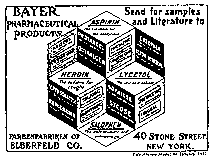
Coke & Heroin
With the exception of alcohol, cocaine and heroin addiction produce more visible
human casualties than any other drug. I had a close friend who went from being
a charming, vibrant fellow (albeit insecure) to first a serious coke user (everyday
for over a year). As he became more paranoid and insecure from the heavy coke
use, he started snorting heroin recreationally. Within about 6-9 months, if not
sooner (he may have hidden it for a while), he had increased his daily habit from
$25 to $75. Then he converted to injections to increase the effectiveness of the
dose and decrease his daily habit to about $50. Throughout this time he became
wrapped up in the cycle of getting money, usually through selling coke and heroin
to other users, and then squandering it on his own habits. By this time his former
vibrancy was reduced to a superficial friendliness, as he withdrew into his room
and his world of smack and speedballs. A Catholic child of the well- off Bay Area
suburbs, he is a typical New Junkie of the late '70s and early '80s.
Coke and heroin have become readily available in any neighborhood. As many a mechanic
or underwriter has discovered, drugs are more lucrative than any salaried or waged
activity: "There is so much money to be made that average middle- class people
are going into coke and heroin dealing,'' reports Sterling Johnson Jr., New York's
Special Narcotics Prosecutor. "They know the odds are on their side, that most
dealers who take care of friends and neighbors don't get caught.''
The illegal drug industry also provides a unique chance to cross class lines in
the current range of economic "opportunities.'' Poor street kids can grow up to
get a piece of multi-million dollar heroin and cocaine markets. The city of Oakland
California has a population of 350,000, of which an estimated 20,000 are heroin
addicts. Based on a $50 a day habit that works out to a $360 million a year heroin
market in Oakland! Six gangs are shooting it out to control it. "Oakland dealers
are now often in their teens, and their leaders are in their early 20s. . . many
dealers employ youngsters as young as 12 or 13 to serve as lookouts and yell if
they see cops or other enemies. Those jobs are in such demand that some gangs
have waiting lists of youngsters eager to go to work. 'When you're 13 and somebody
offers you $50 a day to hang out and watch a street corner, you're not going to
get a paper route,' said an Oakland narcotics officer.'' [San Jose Mercury
News, May 1, 1984]
The plain logic of this situation reveals the blatant hypocrisy of capitalist
society. The successful entrepreneur, who "finds a need and fills it,'' is extolled
as the role model. But in the midst of the squalor or urban ghettoes in every
U.S. city are wildly successful practitioners of this credo who are thought
of as criminals, "hardcore unemployed,'' and economically inactive.
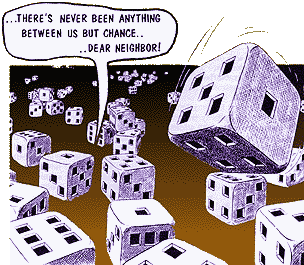
graphic by J.F.Batellier
Conclusion
The "drug scene'' is a violent, alienated and manipulative arena of life. But
the scene is largely defined by its repression. Were illegal drugs decriminalized,
and had we access to complete drug information, we could make intelligent decisions
about what drugs to use and in what circumstances they might be useful or pleasurable.
The free, moderate use of drugs in a supportive human environment could be a widely
shared pleasure.
However, drugs are a commodity, uniquely capable of altering moods, thoughts,
perceptions, but nevertheless a commodity. This means that the production and
distribution of drugs is an alienated and money-coerced activity. The industry
is producing both small businesspeople and millionaires. It is part of the cash
economy, providing a buy-and-sell lifestyle for economically "marginalized'' people.
Paying for drugs is also a continuing reason for people to work at useless and
painful jobs. At the same time drugs are the means for making such work physically
and emotionally tolerable. Although drugs are useful tools in self- exploration
and psychic experimentation, the drug culture co-opts these pursuits into money-making
activities.
Illegal drugs are a remarkably effective institution for turning poor communities
against themselves and producing an atmosphere of isolation and terror. So long
as drugs are kept illegal, people are impelled to prey on each other to be able
to pay the high prices.
Illegal drug use also provides people with the illusion of being "outside the
system'' even when they are reinforcing it through self-induced passivity, escapism,
and consumerism. Ultimately the lawbreaking through drug use reduces rebellion
against the law's authority to the consumption of commodities.
As for the real problem of widespread addiction, the only hope for most addicts
is a genuine social upheaval, and even that may not be enough to break through
the passivity and despair of many junkies. Anything short of a strong reassertion
of human community and a newfound delight in social activity will fail to turn
the junkie back on to the pleasures of social intercourse. The cure for addiction
will not be a technical fix, a new drug, or the right program. It will come when
life is too exciting to simply get high.
—Lucius Cabins

HOME







